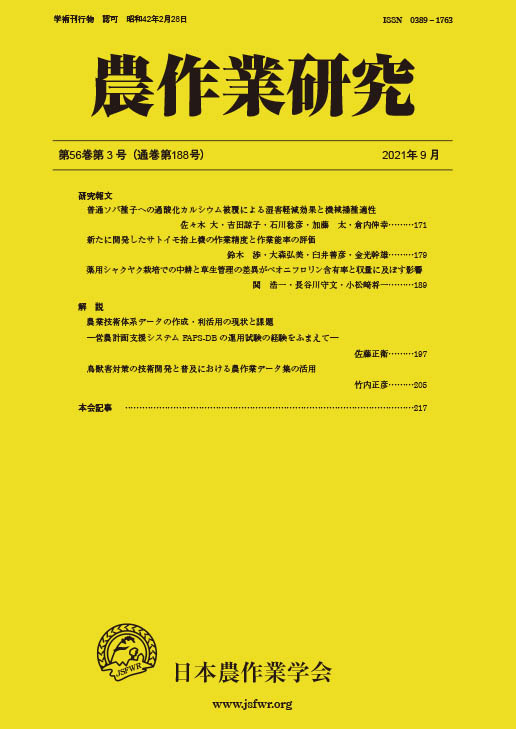
- Issue 4 Pages 227-
- Issue 3 Pages 171-
- Issue 2 Pages 69-
- Issue 1 Pages 5-
- |<
- <
- 1
- >
- >|
-
Futoshi SASAKI, Ryoko YOSHIDA, Toshihiko ISHIKAWA, Futoshi KATO, Nobuy ...2021Volume 56Issue 3 Pages 171-177
Published: September 20, 2021
Released on J-STAGE: March 20, 2022
JOURNAL FREE ACCESSWe dressed the buckwheat (Fagopyrum esculentum Moench) seeds with the calcium peroxide agent and investigated the effects on emergence under excess-moisture and the suitability of dressed seeds for mechanical sowing. The coating amounts of calcium peroxide were 0.5, 1, 1.5, and 2 times the weight of the buckwheat seeds. The flooded treatment was performed for 1-5 days from the day of sowing, and the next test was performed immediately after sowing and 1 to 4 days after sowing, each for 24 hours. The emergence rate was higher in seeds coated 1.5 and 2 times the weight of buckwheat seeds than in the uncoated ones. In particular, the emergence rate in waterlogging for 4 or 5 days was more than twice that of uncoated excess-moisture. It was clarified that a 1.5-and 2 times coating promoted emergence under excess-moisture conditions, and it was suggested that the decrease in yield due to delayed budding could be prevented. In contrast, the emergence rate was significantly lower in those coated 0.5 times the weight of buckwheat seeds than in the uncoated ones. When the coated seeds were dropped from the four types of sowing machines, the coating with 2 times the weight of buckwheat seeds showed the least amount of calcium peroxide released on any machine.
View full abstractDownload PDF (638K) -
Wataru SUZUKI, Hiromi OHMORI, Yoshihiko USUI, Mikio KANAMITSU2021Volume 56Issue 3 Pages 179-187
Published: September 20, 2021
Released on J-STAGE: March 20, 2022
JOURNAL FREE ACCESSThe purpose of this study is to reduce the labor required for the taro harvesting process after digging by a digging and separating machine. The process involves picking up taros from ridges, separating daughter tubers from mother tubers, and placing them in a container. First, we developed a prototype taro picker comprising a pick-up unit, conveyor transfer unit, and rotary transfer unit. A commercial walking-type onion picker was used as the base machine. The primary modifications were alterations to the rods of the pick-up conveyor and the addition of a conveyor belt. Furthermore, the rotary transfer unit comprised a screw blade, and a cylindrical sieve was joined to the rear of the base machine. Subsequently, we developed a mechanized harvesting system consisting of a prototype picker and a transport vehicle. During the harvesting process, a majority of clods were removed through the rotary transfer unit after the taros and soil clods were picked up by the conveyor. The taros transported from the chute of the rotary transfer unit were collected in a flexible container bag on a transport vehicle. The results of our experimental study indicate a harvesting success rate of 95.2% at a working speed of 0.05 m/s. In harvested containers, the ratio of clod weight to the total weight of taros was 7.2%, and the ratio of damaged tubers to total tubers was 3.1%. Furthermore, the work efficiency was 19.5 person・h/10a, which is three times that of the conventional system.
View full abstractDownload PDF (1328K) -
Hiroichi SEKI, Morifumi HASEGAWA, Masakazu KOMATSUZAKI2021Volume 56Issue 3 Pages 189-196
Published: September 20, 2021
Released on J-STAGE: March 20, 2022
JOURNAL FREE ACCESSIn the cultivation of the medical peony (Paeonia lactiflora Pallas), effect of inter-tillage in the medical peony cultivation and grass managements on paeoniflorin ingredient and yield was investigated. The experiment was conducted on cultivation and grass managements at Tsukuba medicinal herb research institute Tsukuba Peony Garden. From the result, inter-tillage management substantially reduced weed biomass compared with grass management, and the yield of peony and content of paeonifrorin were different between the inter-tillage and the grass management. In the field experiment that grew second-year peony, there was no significant difference in paeoniflorin content in August, 2014.Positive correlations between dry weight of root and aboveground dry weight, and between paeoniflorin content and weed biomass were observed. And paeoniflorin content and yields were both higher in the grass management than in the inter-tillage in November, 2014. In the field that grew 5 year-peony, paeoniflorin content was higher in the grass management, and root dry weight was higher in the inter-tillage in October, 2017.
Negative correlations between root dry weight and aboveground dry weight, and between weed biomass and root dry weight were found in 2017. Positive correlation between paeoniflorin content and weed biomass was also observed. In the grass management, paeoniflorin content tended to increase because of the competition between peony and weed grass.
View full abstractDownload PDF (1184K)
-
based on FAPS-DB System Operation ExperienceMasaei SATO2021Volume 56Issue 3 Pages 197-203
Published: September 20, 2021
Released on J-STAGE: March 20, 2022
JOURNAL FREE ACCESSThe system operation test on the Farming-systems Analysis and Planning Support Database (FAPS-DB) was conducted. From the results, we firstly showed how to create the farming technology data in order to be entered into the database. Secondly, we explained that farm work data is the basis of farming technology system data and that it plays a key role in the effective use of FAPS-DB. Lastly, we described the current trends on the methods of creating farming technology system data from farm management software by data cooperation and the future prospects.
View full abstractDownload PDF (666K) -
Masahiko TAKEUCHI2021Volume 56Issue 3 Pages 205-216
Published: September 20, 2021
Released on J-STAGE: March 20, 2022
JOURNAL FREE ACCESSDownload PDF (975K)
- |<
- <
- 1
- >
- >|